Kai Ma
School of Electrical Engineering, Yanshan University, Qinhuangdao, China
VRoPE: Rotary Position Embedding for Video Large Language Models
Feb 17, 2025Abstract:Rotary Position Embedding (RoPE) has shown strong performance in text-based Large Language Models (LLMs), but extending it to video remains a challenge due to the intricate spatiotemporal structure of video frames. Existing adaptations, such as RoPE-3D, attempt to encode spatial and temporal dimensions separately but suffer from two major limitations: positional bias in attention distribution and disruptions in video-text transitions. To overcome these issues, we propose Video Rotary Position Embedding (VRoPE), a novel positional encoding method tailored for Video-LLMs. Our approach restructures positional indices to preserve spatial coherence and ensure a smooth transition between video and text tokens. Additionally, we introduce a more balanced encoding strategy that mitigates attention biases, ensuring a more uniform distribution of spatial focus. Extensive experiments on Vicuna and Qwen2 across different model scales demonstrate that VRoPE consistently outperforms previous RoPE variants, achieving significant improvements in video understanding, temporal reasoning, and retrieval tasks. Code will be available at https://github.com/johncaged/VRoPE
Unveiling the Capabilities of Large Language Models in Detecting Offensive Language with Annotation Disagreement
Feb 10, 2025Abstract:LLMs are widely used for offensive language detection due to their advanced capability. However, the challenges posed by human annotation disagreement in real-world datasets remain underexplored. These disagreement samples are difficult to detect due to their ambiguous nature. Additionally, the confidence of LLMs in processing disagreement samples can provide valuable insights into their alignment with human annotators. To address this gap, we systematically evaluate the ability of LLMs to detect offensive language with annotation disagreement. We compare the binary accuracy of multiple LLMs across varying annotation agreement levels and analyze the relationship between LLM confidence and annotation agreement. Furthermore, we investigate the impact of disagreement samples on LLM decision-making during few-shot learning and instruction fine-tuning. Our findings highlight the challenges posed by disagreement samples and offer guidance for improving LLM-based offensive language detection.
Motion-Aware Generative Frame Interpolation
Jan 07, 2025Abstract:Generative frame interpolation, empowered by large-scale pre-trained video generation models, has demonstrated remarkable advantages in complex scenes. However, existing methods heavily rely on the generative model to independently infer the correspondences between input frames, an ability that is inadequately developed during pre-training. In this work, we propose a novel framework, termed Motion-aware Generative frame interpolation (MoG), to significantly enhance the model's motion awareness by integrating explicit motion guidance. Specifically we investigate two key questions: what can serve as an effective motion guidance, and how we can seamlessly embed this guidance into the generative model. For the first question, we reveal that the intermediate flow from flow-based interpolation models could efficiently provide task-oriented motion guidance. Regarding the second, we first obtain guidance-based representations of intermediate frames by warping input frames' representations using guidance, and then integrate them into the model at both latent and feature levels. To demonstrate the versatility of our method, we train MoG on both real-world and animation datasets. Comprehensive evaluations show that our MoG significantly outperforms the existing methods in both domains, achieving superior video quality and improved fidelity.
Make-It-Animatable: An Efficient Framework for Authoring Animation-Ready 3D Characters
Nov 27, 2024



Abstract:3D characters are essential to modern creative industries, but making them animatable often demands extensive manual work in tasks like rigging and skinning. Existing automatic rigging tools face several limitations, including the necessity for manual annotations, rigid skeleton topologies, and limited generalization across diverse shapes and poses. An alternative approach is to generate animatable avatars pre-bound to a rigged template mesh. However, this method often lacks flexibility and is typically limited to realistic human shapes. To address these issues, we present Make-It-Animatable, a novel data-driven method to make any 3D humanoid model ready for character animation in less than one second, regardless of its shapes and poses. Our unified framework generates high-quality blend weights, bones, and pose transformations. By incorporating a particle-based shape autoencoder, our approach supports various 3D representations, including meshes and 3D Gaussian splats. Additionally, we employ a coarse-to-fine representation and a structure-aware modeling strategy to ensure both accuracy and robustness, even for characters with non-standard skeleton structures. We conducted extensive experiments to validate our framework's effectiveness. Compared to existing methods, our approach demonstrates significant improvements in both quality and speed.
SciSafeEval: A Comprehensive Benchmark for Safety Alignment of Large Language Models in Scientific Tasks
Oct 02, 2024



Abstract:Large language models (LLMs) have had a transformative impact on a variety of scientific tasks across disciplines such as biology, chemistry, medicine, and physics. However, ensuring the safety alignment of these models in scientific research remains an underexplored area, with existing benchmarks primarily focus on textual content and overlooking key scientific representations such as molecular, protein, and genomic languages. Moreover, the safety mechanisms of LLMs in scientific tasks are insufficiently studied. To address these limitations, we introduce SciSafeEval, a comprehensive benchmark designed to evaluate the safety alignment of LLMs across a range of scientific tasks. SciSafeEval spans multiple scientific languages - including textual, molecular, protein, and genomic - and covers a wide range of scientific domains. We evaluate LLMs in zero-shot, few-shot and chain-of-thought settings, and introduce a 'jailbreak' enhancement feature that challenges LLMs equipped with safety guardrails, rigorously testing their defenses against malicious intention. Our benchmark surpasses existing safety datasets in both scale and scope, providing a robust platform for assessing the safety and performance of LLMs in scientific contexts. This work aims to facilitate the responsible development and deployment of LLMs, promoting alignment with safety and ethical standards in scientific research.
FreeEdit: Mask-free Reference-based Image Editing with Multi-modal Instruction
Sep 26, 2024Abstract:Introducing user-specified visual concepts in image editing is highly practical as these concepts convey the user's intent more precisely than text-based descriptions. We propose FreeEdit, a novel approach for achieving such reference-based image editing, which can accurately reproduce the visual concept from the reference image based on user-friendly language instructions. Our approach leverages the multi-modal instruction encoder to encode language instructions to guide the editing process. This implicit way of locating the editing area eliminates the need for manual editing masks. To enhance the reconstruction of reference details, we introduce the Decoupled Residual ReferAttention (DRRA) module. This module is designed to integrate fine-grained reference features extracted by a detail extractor into the image editing process in a residual way without interfering with the original self-attention. Given that existing datasets are unsuitable for reference-based image editing tasks, particularly due to the difficulty in constructing image triplets that include a reference image, we curate a high-quality dataset, FreeBench, using a newly developed twice-repainting scheme. FreeBench comprises the images before and after editing, detailed editing instructions, as well as a reference image that maintains the identity of the edited object, encompassing tasks such as object addition, replacement, and deletion. By conducting phased training on FreeBench followed by quality tuning, FreeEdit achieves high-quality zero-shot editing through convenient language instructions. We conduct extensive experiments to evaluate the effectiveness of FreeEdit across multiple task types, demonstrating its superiority over existing methods. The code will be available at: https://freeedit.github.io/.
IFAdapter: Instance Feature Control for Grounded Text-to-Image Generation
Sep 12, 2024



Abstract:While Text-to-Image (T2I) diffusion models excel at generating visually appealing images of individual instances, they struggle to accurately position and control the features generation of multiple instances. The Layout-to-Image (L2I) task was introduced to address the positioning challenges by incorporating bounding boxes as spatial control signals, but it still falls short in generating precise instance features. In response, we propose the Instance Feature Generation (IFG) task, which aims to ensure both positional accuracy and feature fidelity in generated instances. To address the IFG task, we introduce the Instance Feature Adapter (IFAdapter). The IFAdapter enhances feature depiction by incorporating additional appearance tokens and utilizing an Instance Semantic Map to align instance-level features with spatial locations. The IFAdapter guides the diffusion process as a plug-and-play module, making it adaptable to various community models. For evaluation, we contribute an IFG benchmark and develop a verification pipeline to objectively compare models' abilities to generate instances with accurate positioning and features. Experimental results demonstrate that IFAdapter outperforms other models in both quantitative and qualitative evaluations.
Towards Patronizing and Condescending Language in Chinese Videos: A Multimodal Dataset and Detector
Sep 10, 2024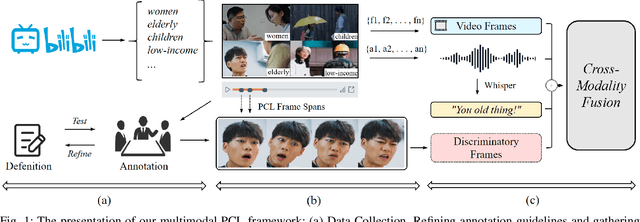
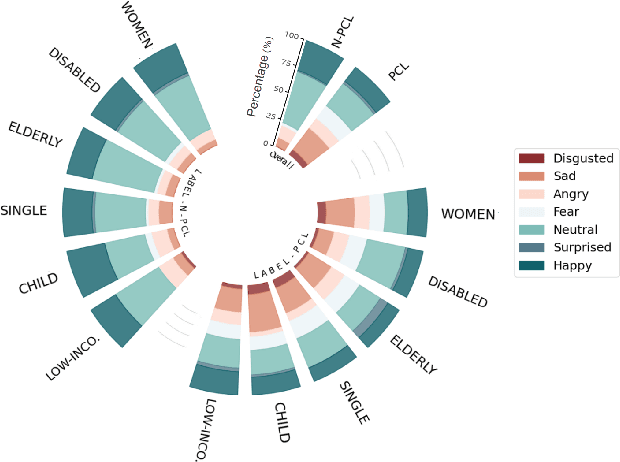
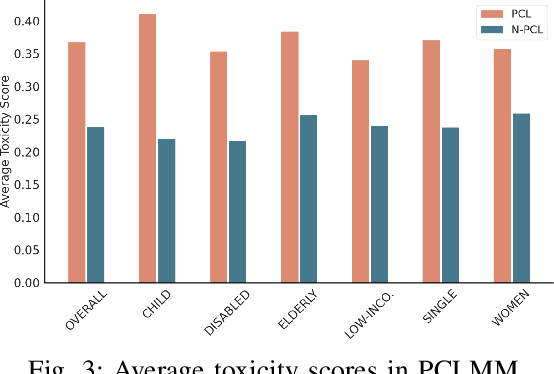

Abstract:Patronizing and Condescending Language (PCL) is a form of discriminatory toxic speech targeting vulnerable groups, threatening both online and offline safety. While toxic speech research has mainly focused on overt toxicity, such as hate speech, microaggressions in the form of PCL remain underexplored. Additionally, dominant groups' discriminatory facial expressions and attitudes toward vulnerable communities can be more impactful than verbal cues, yet these frame features are often overlooked. In this paper, we introduce the PCLMM dataset, the first Chinese multimodal dataset for PCL, consisting of 715 annotated videos from Bilibili, with high-quality PCL facial frame spans. We also propose the MultiPCL detector, featuring a facial expression detection module for PCL recognition, demonstrating the effectiveness of modality complementarity in this challenging task. Our work makes an important contribution to advancing microaggression detection within the domain of toxic speech.
Dynamic and Compressive Adaptation of Transformers From Images to Videos
Aug 14, 2024
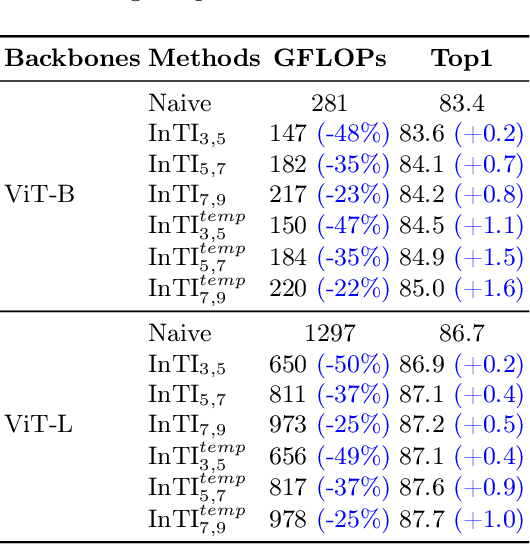
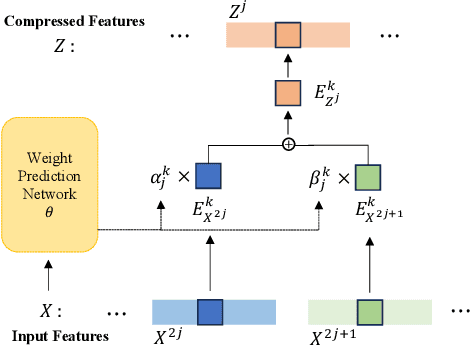
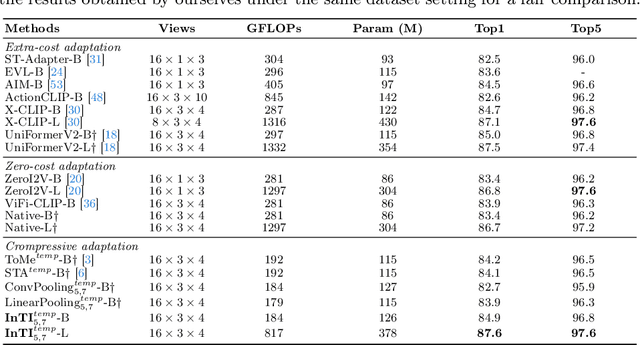
Abstract:Recently, the remarkable success of pre-trained Vision Transformers (ViTs) from image-text matching has sparked an interest in image-to-video adaptation. However, most current approaches retain the full forward pass for each frame, leading to a high computation overhead for processing entire videos. In this paper, we present InTI, a novel approach for compressive image-to-video adaptation using dynamic Inter-frame Token Interpolation. InTI aims to softly preserve the informative tokens without disrupting their coherent spatiotemporal structure. Specifically, each token pair at identical positions within neighbor frames is linearly aggregated into a new token, where the aggregation weights are generated by a multi-scale context-aware network. In this way, the information of neighbor frames can be adaptively compressed in a point-by-point manner, thereby effectively reducing the number of processed frames by half each time. Importantly, InTI can be seamlessly integrated with existing adaptation methods, achieving strong performance without extra-complex design. On Kinetics-400, InTI reaches a top-1 accuracy of 87.1 with a remarkable 37.5% reduction in GFLOPs compared to naive adaptation. When combined with additional temporal modules, InTI achieves a top-1 accuracy of 87.6 with a 37% reduction in GFLOPs. Similar conclusions have been verified in other common datasets.
VFIMamba: Video Frame Interpolation with State Space Models
Jul 02, 2024Abstract:Inter-frame modeling is pivotal in generating intermediate frames for video frame interpolation (VFI). Current approaches predominantly rely on convolution or attention-based models, which often either lack sufficient receptive fields or entail significant computational overheads. Recently, Selective State Space Models (S6) have emerged, tailored specifically for long sequence modeling, offering both linear complexity and data-dependent modeling capabilities. In this paper, we propose VFIMamba, a novel frame interpolation method for efficient and dynamic inter-frame modeling by harnessing the S6 model. Our approach introduces the Mixed-SSM Block (MSB), which initially rearranges tokens from adjacent frames in an interleaved fashion and subsequently applies multi-directional S6 modeling. This design facilitates the efficient transmission of information across frames while upholding linear complexity. Furthermore, we introduce a novel curriculum learning strategy that progressively cultivates proficiency in modeling inter-frame dynamics across varying motion magnitudes, fully unleashing the potential of the S6 model. Experimental findings showcase that our method attains state-of-the-art performance across diverse benchmarks, particularly excelling in high-resolution scenarios. In particular, on the X-TEST dataset, VFIMamba demonstrates a noteworthy improvement of 0.80 dB for 4K frames and 0.96 dB for 2K frames.
 Add to Chrome
Add to Chrome Add to Firefox
Add to Firefox Add to Edge
Add to Edge